Financial Analysis Report: Woodside Petroleum Performance (FBL5030)
VerifiedAdded on 2023/02/01
|23
|6043
|95
Report
AI Summary
This report presents a financial performance analysis of Woodside Petroleum from 2014 to 2018, focusing on profitability, liquidity, and solvency. The analysis employs financial ratio analysis, comparing Woodside's performance with its competitor Santos Limited and industry averages. The report includes an executive summary, introduction, and detailed sections on profitability (operating profit margin, return on equity, net profit margin), liquidity (current ratio, days receivable ratio, acid test ratio), and solvency (debt ratio, equity ratio, interest coverage ratio). The methodology involves gathering financial data from various sources, calculating relevant ratios, and interpreting the results to evaluate Woodside's financial health and growth prospects. The findings suggest that Woodside generally outperforms its competitor and the industry average in key financial metrics, indicating strong operational efficiency and financial stability. The report concludes with a summary of the company's financial performance and potential for future growth, providing valuable insights for investors and stakeholders. The financial data used in the report includes operating profit, net profit, total revenue, shareholder's equity, current assets, and liabilities, among other items.
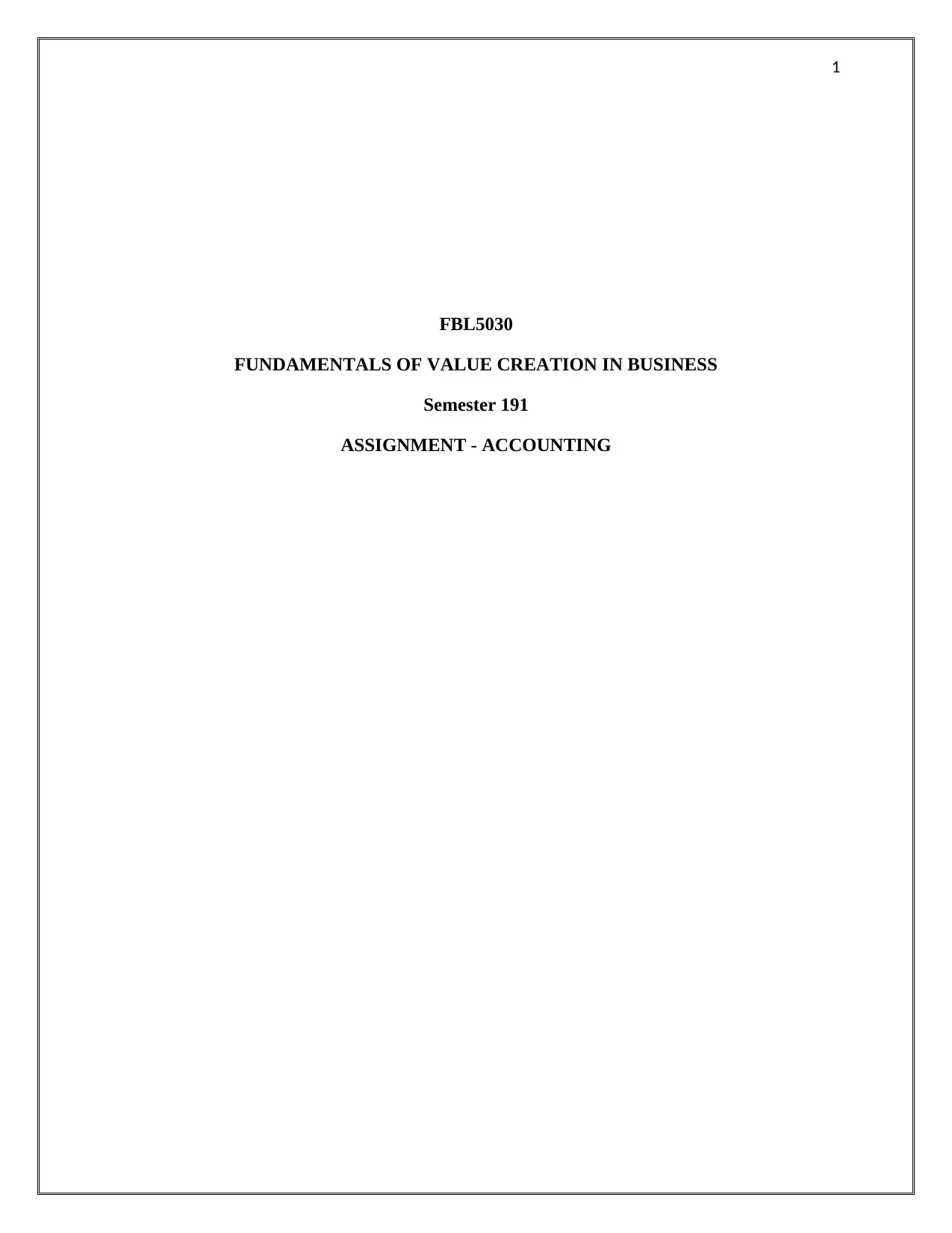
1
FBL5030
FUNDAMENTALS OF VALUE CREATION IN BUSINESS
Semester 191
ASSIGNMENT - ACCOUNTING
FBL5030
FUNDAMENTALS OF VALUE CREATION IN BUSINESS
Semester 191
ASSIGNMENT - ACCOUNTING
Paraphrase This Document
Need a fresh take? Get an instant paraphrase of this document with our AI Paraphraser
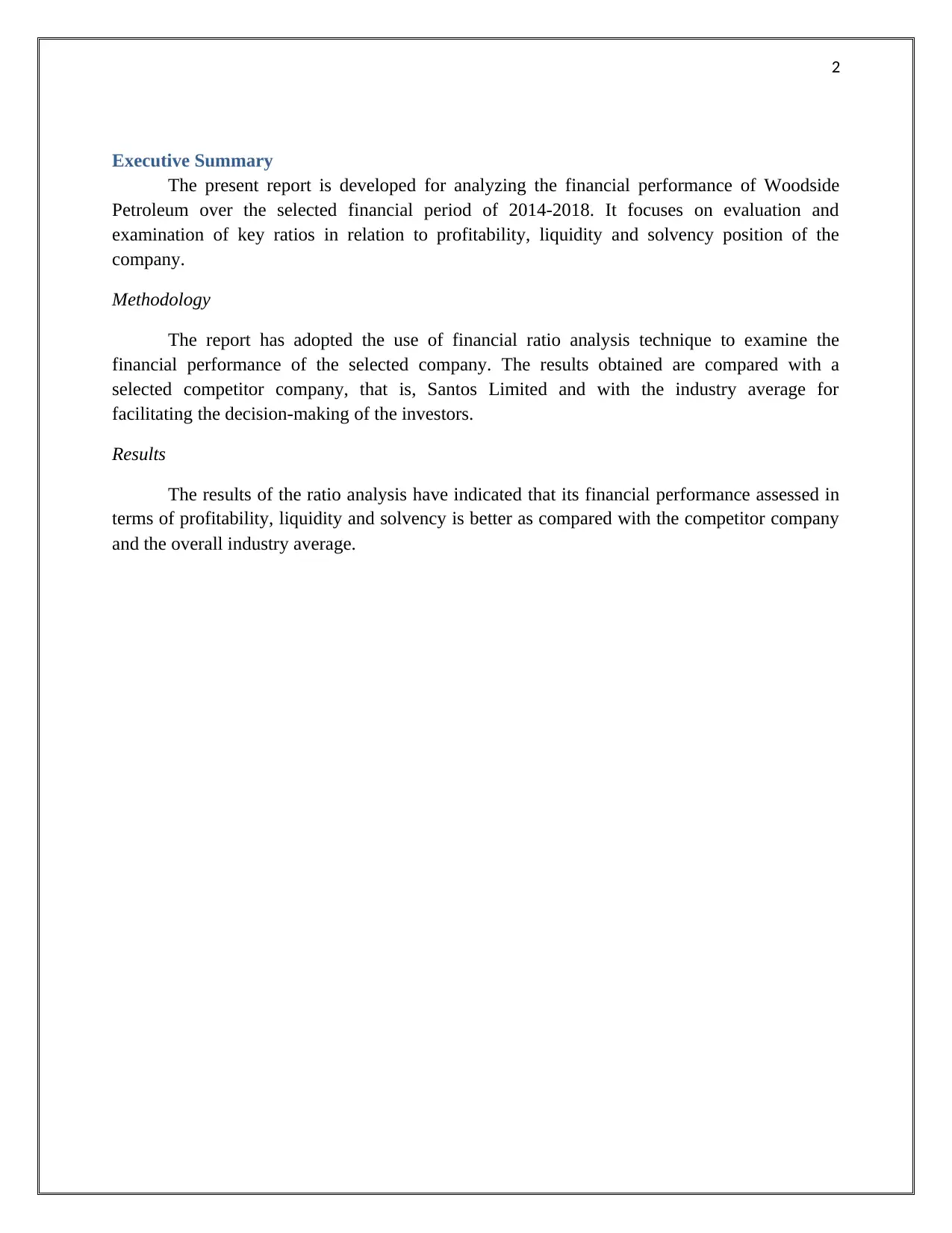
2
Executive Summary
The present report is developed for analyzing the financial performance of Woodside
Petroleum over the selected financial period of 2014-2018. It focuses on evaluation and
examination of key ratios in relation to profitability, liquidity and solvency position of the
company.
Methodology
The report has adopted the use of financial ratio analysis technique to examine the
financial performance of the selected company. The results obtained are compared with a
selected competitor company, that is, Santos Limited and with the industry average for
facilitating the decision-making of the investors.
Results
The results of the ratio analysis have indicated that its financial performance assessed in
terms of profitability, liquidity and solvency is better as compared with the competitor company
and the overall industry average.
Executive Summary
The present report is developed for analyzing the financial performance of Woodside
Petroleum over the selected financial period of 2014-2018. It focuses on evaluation and
examination of key ratios in relation to profitability, liquidity and solvency position of the
company.
Methodology
The report has adopted the use of financial ratio analysis technique to examine the
financial performance of the selected company. The results obtained are compared with a
selected competitor company, that is, Santos Limited and with the industry average for
facilitating the decision-making of the investors.
Results
The results of the ratio analysis have indicated that its financial performance assessed in
terms of profitability, liquidity and solvency is better as compared with the competitor company
and the overall industry average.
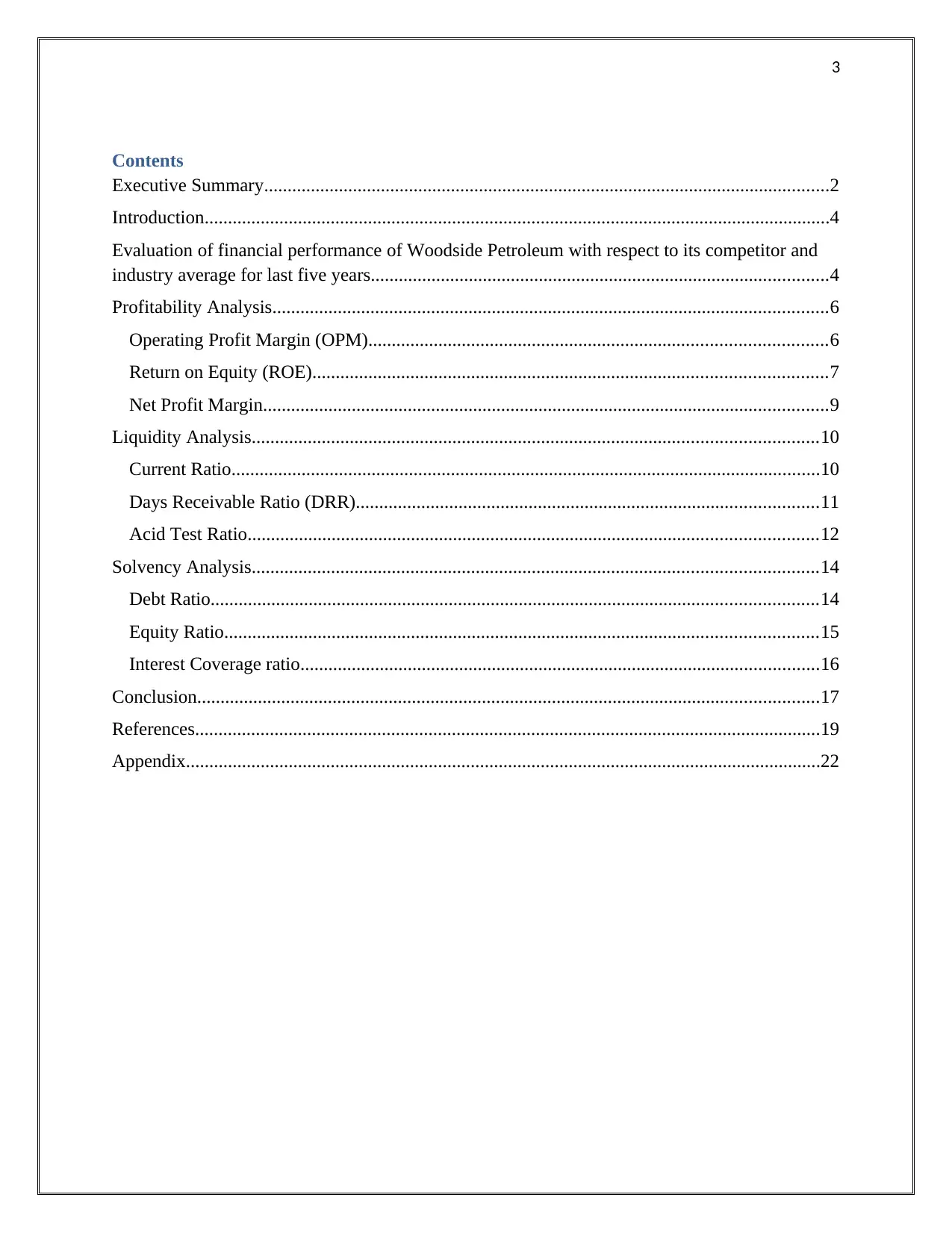
3
Contents
Executive Summary.........................................................................................................................2
Introduction......................................................................................................................................4
Evaluation of financial performance of Woodside Petroleum with respect to its competitor and
industry average for last five years..................................................................................................4
Profitability Analysis.......................................................................................................................6
Operating Profit Margin (OPM)..................................................................................................6
Return on Equity (ROE)..............................................................................................................7
Net Profit Margin.........................................................................................................................9
Liquidity Analysis.........................................................................................................................10
Current Ratio..............................................................................................................................10
Days Receivable Ratio (DRR)...................................................................................................11
Acid Test Ratio..........................................................................................................................12
Solvency Analysis.........................................................................................................................14
Debt Ratio..................................................................................................................................14
Equity Ratio...............................................................................................................................15
Interest Coverage ratio...............................................................................................................16
Conclusion.....................................................................................................................................17
References......................................................................................................................................19
Appendix........................................................................................................................................22
Contents
Executive Summary.........................................................................................................................2
Introduction......................................................................................................................................4
Evaluation of financial performance of Woodside Petroleum with respect to its competitor and
industry average for last five years..................................................................................................4
Profitability Analysis.......................................................................................................................6
Operating Profit Margin (OPM)..................................................................................................6
Return on Equity (ROE)..............................................................................................................7
Net Profit Margin.........................................................................................................................9
Liquidity Analysis.........................................................................................................................10
Current Ratio..............................................................................................................................10
Days Receivable Ratio (DRR)...................................................................................................11
Acid Test Ratio..........................................................................................................................12
Solvency Analysis.........................................................................................................................14
Debt Ratio..................................................................................................................................14
Equity Ratio...............................................................................................................................15
Interest Coverage ratio...............................................................................................................16
Conclusion.....................................................................................................................................17
References......................................................................................................................................19
Appendix........................................................................................................................................22
⊘ This is a preview!⊘
Do you want full access?
Subscribe today to unlock all pages.

Trusted by 1+ million students worldwide
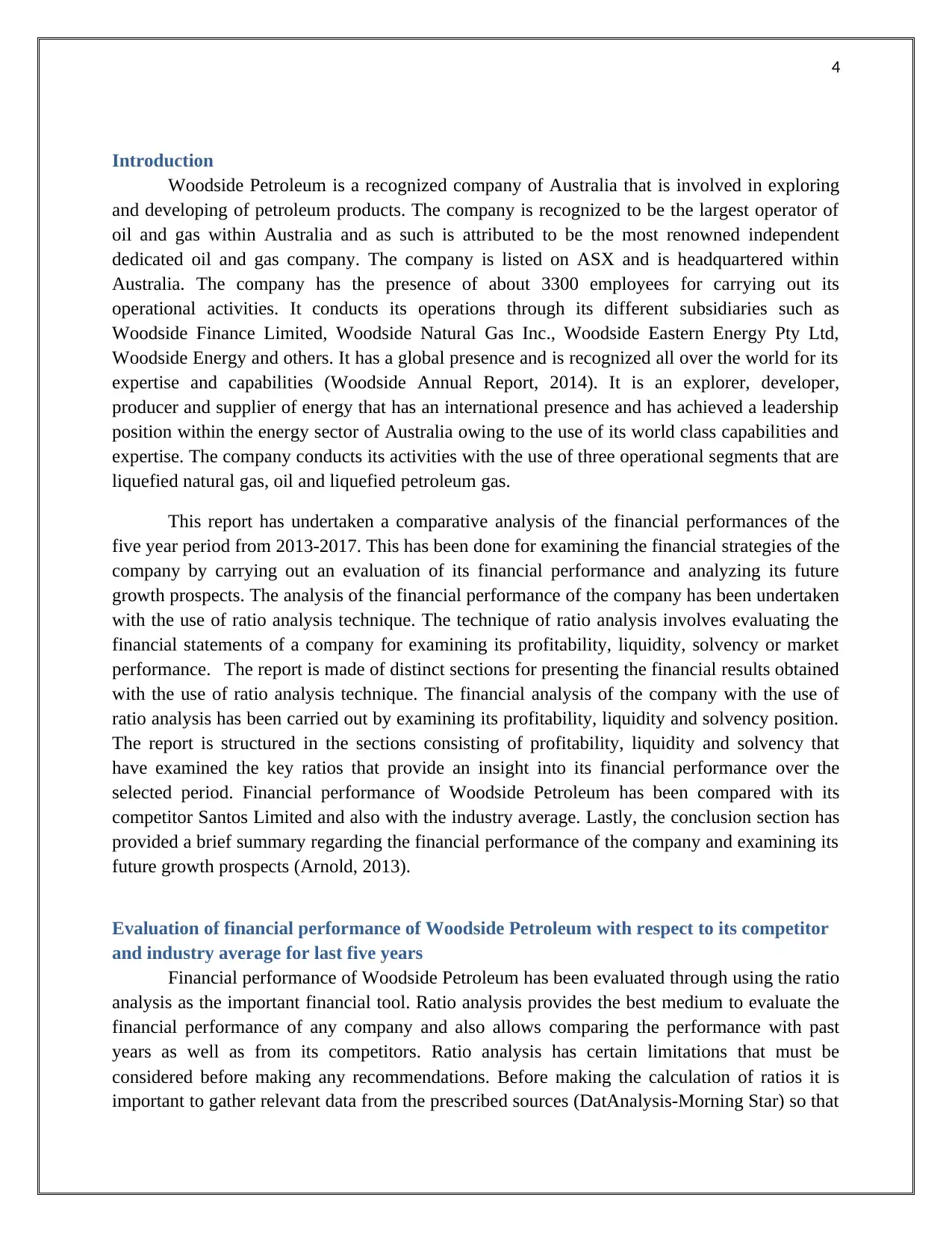
4
Introduction
Woodside Petroleum is a recognized company of Australia that is involved in exploring
and developing of petroleum products. The company is recognized to be the largest operator of
oil and gas within Australia and as such is attributed to be the most renowned independent
dedicated oil and gas company. The company is listed on ASX and is headquartered within
Australia. The company has the presence of about 3300 employees for carrying out its
operational activities. It conducts its operations through its different subsidiaries such as
Woodside Finance Limited, Woodside Natural Gas Inc., Woodside Eastern Energy Pty Ltd,
Woodside Energy and others. It has a global presence and is recognized all over the world for its
expertise and capabilities (Woodside Annual Report, 2014). It is an explorer, developer,
producer and supplier of energy that has an international presence and has achieved a leadership
position within the energy sector of Australia owing to the use of its world class capabilities and
expertise. The company conducts its activities with the use of three operational segments that are
liquefied natural gas, oil and liquefied petroleum gas.
This report has undertaken a comparative analysis of the financial performances of the
five year period from 2013-2017. This has been done for examining the financial strategies of the
company by carrying out an evaluation of its financial performance and analyzing its future
growth prospects. The analysis of the financial performance of the company has been undertaken
with the use of ratio analysis technique. The technique of ratio analysis involves evaluating the
financial statements of a company for examining its profitability, liquidity, solvency or market
performance. The report is made of distinct sections for presenting the financial results obtained
with the use of ratio analysis technique. The financial analysis of the company with the use of
ratio analysis has been carried out by examining its profitability, liquidity and solvency position.
The report is structured in the sections consisting of profitability, liquidity and solvency that
have examined the key ratios that provide an insight into its financial performance over the
selected period. Financial performance of Woodside Petroleum has been compared with its
competitor Santos Limited and also with the industry average. Lastly, the conclusion section has
provided a brief summary regarding the financial performance of the company and examining its
future growth prospects (Arnold, 2013).
Evaluation of financial performance of Woodside Petroleum with respect to its competitor
and industry average for last five years
Financial performance of Woodside Petroleum has been evaluated through using the ratio
analysis as the important financial tool. Ratio analysis provides the best medium to evaluate the
financial performance of any company and also allows comparing the performance with past
years as well as from its competitors. Ratio analysis has certain limitations that must be
considered before making any recommendations. Before making the calculation of ratios it is
important to gather relevant data from the prescribed sources (DatAnalysis-Morning Star) so that
Introduction
Woodside Petroleum is a recognized company of Australia that is involved in exploring
and developing of petroleum products. The company is recognized to be the largest operator of
oil and gas within Australia and as such is attributed to be the most renowned independent
dedicated oil and gas company. The company is listed on ASX and is headquartered within
Australia. The company has the presence of about 3300 employees for carrying out its
operational activities. It conducts its operations through its different subsidiaries such as
Woodside Finance Limited, Woodside Natural Gas Inc., Woodside Eastern Energy Pty Ltd,
Woodside Energy and others. It has a global presence and is recognized all over the world for its
expertise and capabilities (Woodside Annual Report, 2014). It is an explorer, developer,
producer and supplier of energy that has an international presence and has achieved a leadership
position within the energy sector of Australia owing to the use of its world class capabilities and
expertise. The company conducts its activities with the use of three operational segments that are
liquefied natural gas, oil and liquefied petroleum gas.
This report has undertaken a comparative analysis of the financial performances of the
five year period from 2013-2017. This has been done for examining the financial strategies of the
company by carrying out an evaluation of its financial performance and analyzing its future
growth prospects. The analysis of the financial performance of the company has been undertaken
with the use of ratio analysis technique. The technique of ratio analysis involves evaluating the
financial statements of a company for examining its profitability, liquidity, solvency or market
performance. The report is made of distinct sections for presenting the financial results obtained
with the use of ratio analysis technique. The financial analysis of the company with the use of
ratio analysis has been carried out by examining its profitability, liquidity and solvency position.
The report is structured in the sections consisting of profitability, liquidity and solvency that
have examined the key ratios that provide an insight into its financial performance over the
selected period. Financial performance of Woodside Petroleum has been compared with its
competitor Santos Limited and also with the industry average. Lastly, the conclusion section has
provided a brief summary regarding the financial performance of the company and examining its
future growth prospects (Arnold, 2013).
Evaluation of financial performance of Woodside Petroleum with respect to its competitor
and industry average for last five years
Financial performance of Woodside Petroleum has been evaluated through using the ratio
analysis as the important financial tool. Ratio analysis provides the best medium to evaluate the
financial performance of any company and also allows comparing the performance with past
years as well as from its competitors. Ratio analysis has certain limitations that must be
considered before making any recommendations. Before making the calculation of ratios it is
important to gather relevant data from the prescribed sources (DatAnalysis-Morning Star) so that
Paraphrase This Document
Need a fresh take? Get an instant paraphrase of this document with our AI Paraphraser
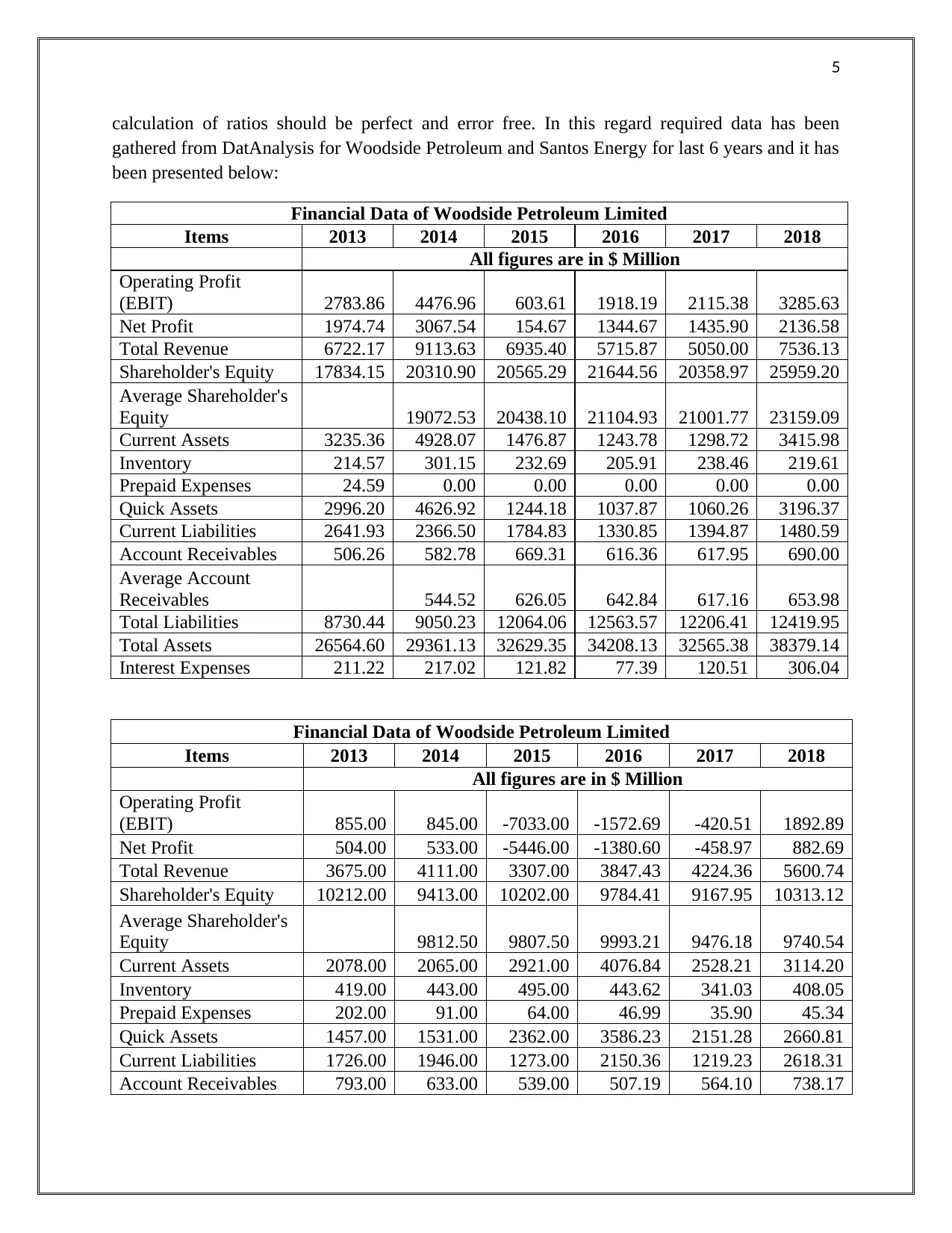
5
calculation of ratios should be perfect and error free. In this regard required data has been
gathered from DatAnalysis for Woodside Petroleum and Santos Energy for last 6 years and it has
been presented below:
Financial Data of Woodside Petroleum Limited
Items 2013 2014 2015 2016 2017 2018
All figures are in $ Million
Operating Profit
(EBIT) 2783.86 4476.96 603.61 1918.19 2115.38 3285.63
Net Profit 1974.74 3067.54 154.67 1344.67 1435.90 2136.58
Total Revenue 6722.17 9113.63 6935.40 5715.87 5050.00 7536.13
Shareholder's Equity 17834.15 20310.90 20565.29 21644.56 20358.97 25959.20
Average Shareholder's
Equity 19072.53 20438.10 21104.93 21001.77 23159.09
Current Assets 3235.36 4928.07 1476.87 1243.78 1298.72 3415.98
Inventory 214.57 301.15 232.69 205.91 238.46 219.61
Prepaid Expenses 24.59 0.00 0.00 0.00 0.00 0.00
Quick Assets 2996.20 4626.92 1244.18 1037.87 1060.26 3196.37
Current Liabilities 2641.93 2366.50 1784.83 1330.85 1394.87 1480.59
Account Receivables 506.26 582.78 669.31 616.36 617.95 690.00
Average Account
Receivables 544.52 626.05 642.84 617.16 653.98
Total Liabilities 8730.44 9050.23 12064.06 12563.57 12206.41 12419.95
Total Assets 26564.60 29361.13 32629.35 34208.13 32565.38 38379.14
Interest Expenses 211.22 217.02 121.82 77.39 120.51 306.04
Financial Data of Woodside Petroleum Limited
Items 2013 2014 2015 2016 2017 2018
All figures are in $ Million
Operating Profit
(EBIT) 855.00 845.00 -7033.00 -1572.69 -420.51 1892.89
Net Profit 504.00 533.00 -5446.00 -1380.60 -458.97 882.69
Total Revenue 3675.00 4111.00 3307.00 3847.43 4224.36 5600.74
Shareholder's Equity 10212.00 9413.00 10202.00 9784.41 9167.95 10313.12
Average Shareholder's
Equity 9812.50 9807.50 9993.21 9476.18 9740.54
Current Assets 2078.00 2065.00 2921.00 4076.84 2528.21 3114.20
Inventory 419.00 443.00 495.00 443.62 341.03 408.05
Prepaid Expenses 202.00 91.00 64.00 46.99 35.90 45.34
Quick Assets 1457.00 1531.00 2362.00 3586.23 2151.28 2660.81
Current Liabilities 1726.00 1946.00 1273.00 2150.36 1219.23 2618.31
Account Receivables 793.00 633.00 539.00 507.19 564.10 738.17
calculation of ratios should be perfect and error free. In this regard required data has been
gathered from DatAnalysis for Woodside Petroleum and Santos Energy for last 6 years and it has
been presented below:
Financial Data of Woodside Petroleum Limited
Items 2013 2014 2015 2016 2017 2018
All figures are in $ Million
Operating Profit
(EBIT) 2783.86 4476.96 603.61 1918.19 2115.38 3285.63
Net Profit 1974.74 3067.54 154.67 1344.67 1435.90 2136.58
Total Revenue 6722.17 9113.63 6935.40 5715.87 5050.00 7536.13
Shareholder's Equity 17834.15 20310.90 20565.29 21644.56 20358.97 25959.20
Average Shareholder's
Equity 19072.53 20438.10 21104.93 21001.77 23159.09
Current Assets 3235.36 4928.07 1476.87 1243.78 1298.72 3415.98
Inventory 214.57 301.15 232.69 205.91 238.46 219.61
Prepaid Expenses 24.59 0.00 0.00 0.00 0.00 0.00
Quick Assets 2996.20 4626.92 1244.18 1037.87 1060.26 3196.37
Current Liabilities 2641.93 2366.50 1784.83 1330.85 1394.87 1480.59
Account Receivables 506.26 582.78 669.31 616.36 617.95 690.00
Average Account
Receivables 544.52 626.05 642.84 617.16 653.98
Total Liabilities 8730.44 9050.23 12064.06 12563.57 12206.41 12419.95
Total Assets 26564.60 29361.13 32629.35 34208.13 32565.38 38379.14
Interest Expenses 211.22 217.02 121.82 77.39 120.51 306.04
Financial Data of Woodside Petroleum Limited
Items 2013 2014 2015 2016 2017 2018
All figures are in $ Million
Operating Profit
(EBIT) 855.00 845.00 -7033.00 -1572.69 -420.51 1892.89
Net Profit 504.00 533.00 -5446.00 -1380.60 -458.97 882.69
Total Revenue 3675.00 4111.00 3307.00 3847.43 4224.36 5600.74
Shareholder's Equity 10212.00 9413.00 10202.00 9784.41 9167.95 10313.12
Average Shareholder's
Equity 9812.50 9807.50 9993.21 9476.18 9740.54
Current Assets 2078.00 2065.00 2921.00 4076.84 2528.21 3114.20
Inventory 419.00 443.00 495.00 443.62 341.03 408.05
Prepaid Expenses 202.00 91.00 64.00 46.99 35.90 45.34
Quick Assets 1457.00 1531.00 2362.00 3586.23 2151.28 2660.81
Current Liabilities 1726.00 1946.00 1273.00 2150.36 1219.23 2618.31
Account Receivables 793.00 633.00 539.00 507.19 564.10 738.17

6
Average Account
Receivables 713.00 586.00 523.10 535.65 651.14
Total Liabilities 10397.00 12932.00 11724.00 11307.35 8403.85 13962.88
Total Assets 20609.00 22345.00 21926.00 21091.76 17571.79 24276.00
Interest Expenses 62.00 116.00 297.00 409.07 376.92 365.54
(Woodside Annual Report, 2014 to 2018), (Santos Annual Report, 2014 to 2018) and (CSI
Market, 2019)
Note 1: Details of ratio calculation has been shown in appendix for further review.
Note 2: Industry average has been taken from CSI Market (Web-link:
https://csimarket.com/Industry/industry_Financial_Strength_Ratios.php?ind=603)
Profitability Analysis
The profitability analysis is carried out for developing an understanding of the ability of a
company to generate profits from its operational activities. The analysis is useful to examine the
profit generating capacity of a company in relation to other companies operating within the same
industry. The analysis has been carried by calculation of the following ratios and comparing the
results obtained within the competitor data obtained from the financial statements of Santos
Limited, a competitor company of Woodside Energy Ltd.
Operating Profit Margin (OPM)
The operating profit margin ratio is used for examining the effectiveness of a company in
managing its operational costs. The analysis of the operating profit margin is very essential for
the companies operating within the energy sector such as Woodside Petroleum as they have to
consistently modify their production levels due to fluctuations in exchange rates and other
factors which have a large impact on the cost of their operations.
The ratio can be calculated with the use of following formula:
Formula: Earnings before interest and tax (EBIT)/ Total Revenue (Brigham & Michael, 2013)
The evaluation of the operating profit margin ration would help in examining the
potential of a company for realizing future growth. It analyzes the financial position of a
company by evaluating its ability to meet its fixed costs and interest’s obligations. The
companies having higher operating profit margins indicates having a control over their
operational costs and thus realizing higher profits.
Operating Profit Margin
Ratios 2014 2015 2016 2017 2018
Woodside Petroleum 49.12% 8.70% 33.56% 41.89% 43.60%
Santos Limited 20.55% -212.67% -40.88% -9.95% 33.80%
Average Account
Receivables 713.00 586.00 523.10 535.65 651.14
Total Liabilities 10397.00 12932.00 11724.00 11307.35 8403.85 13962.88
Total Assets 20609.00 22345.00 21926.00 21091.76 17571.79 24276.00
Interest Expenses 62.00 116.00 297.00 409.07 376.92 365.54
(Woodside Annual Report, 2014 to 2018), (Santos Annual Report, 2014 to 2018) and (CSI
Market, 2019)
Note 1: Details of ratio calculation has been shown in appendix for further review.
Note 2: Industry average has been taken from CSI Market (Web-link:
https://csimarket.com/Industry/industry_Financial_Strength_Ratios.php?ind=603)
Profitability Analysis
The profitability analysis is carried out for developing an understanding of the ability of a
company to generate profits from its operational activities. The analysis is useful to examine the
profit generating capacity of a company in relation to other companies operating within the same
industry. The analysis has been carried by calculation of the following ratios and comparing the
results obtained within the competitor data obtained from the financial statements of Santos
Limited, a competitor company of Woodside Energy Ltd.
Operating Profit Margin (OPM)
The operating profit margin ratio is used for examining the effectiveness of a company in
managing its operational costs. The analysis of the operating profit margin is very essential for
the companies operating within the energy sector such as Woodside Petroleum as they have to
consistently modify their production levels due to fluctuations in exchange rates and other
factors which have a large impact on the cost of their operations.
The ratio can be calculated with the use of following formula:
Formula: Earnings before interest and tax (EBIT)/ Total Revenue (Brigham & Michael, 2013)
The evaluation of the operating profit margin ration would help in examining the
potential of a company for realizing future growth. It analyzes the financial position of a
company by evaluating its ability to meet its fixed costs and interest’s obligations. The
companies having higher operating profit margins indicates having a control over their
operational costs and thus realizing higher profits.
Operating Profit Margin
Ratios 2014 2015 2016 2017 2018
Woodside Petroleum 49.12% 8.70% 33.56% 41.89% 43.60%
Santos Limited 20.55% -212.67% -40.88% -9.95% 33.80%
⊘ This is a preview!⊘
Do you want full access?
Subscribe today to unlock all pages.

Trusted by 1+ million students worldwide
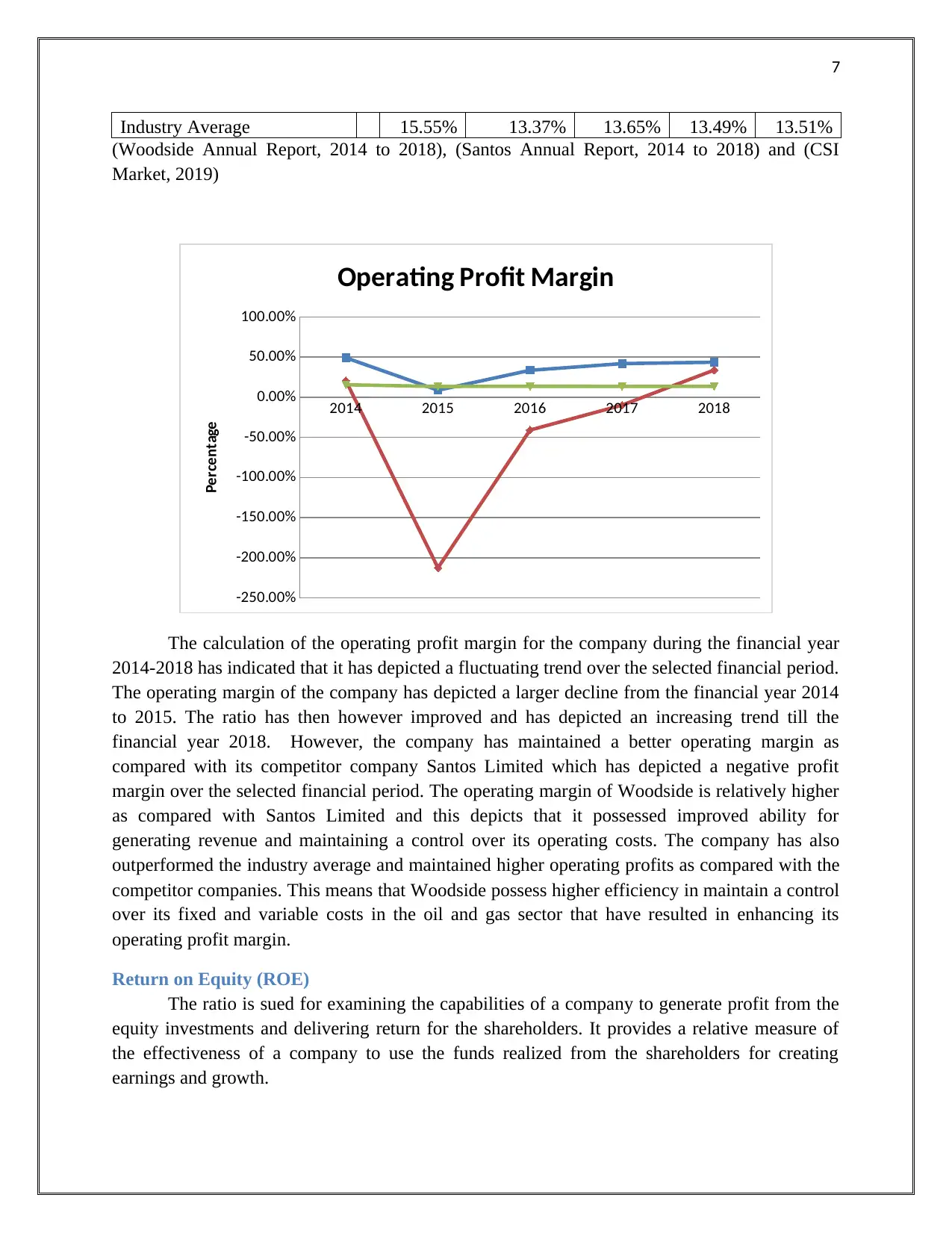
7
Industry Average 15.55% 13.37% 13.65% 13.49% 13.51%
(Woodside Annual Report, 2014 to 2018), (Santos Annual Report, 2014 to 2018) and (CSI
Market, 2019)
2014 2015 2016 2017 2018
-250.00%
-200.00%
-150.00%
-100.00%
-50.00%
0.00%
50.00%
100.00%
Operating Profit Margin
Percentage
The calculation of the operating profit margin for the company during the financial year
2014-2018 has indicated that it has depicted a fluctuating trend over the selected financial period.
The operating margin of the company has depicted a larger decline from the financial year 2014
to 2015. The ratio has then however improved and has depicted an increasing trend till the
financial year 2018. However, the company has maintained a better operating margin as
compared with its competitor company Santos Limited which has depicted a negative profit
margin over the selected financial period. The operating margin of Woodside is relatively higher
as compared with Santos Limited and this depicts that it possessed improved ability for
generating revenue and maintaining a control over its operating costs. The company has also
outperformed the industry average and maintained higher operating profits as compared with the
competitor companies. This means that Woodside possess higher efficiency in maintain a control
over its fixed and variable costs in the oil and gas sector that have resulted in enhancing its
operating profit margin.
Return on Equity (ROE)
The ratio is sued for examining the capabilities of a company to generate profit from the
equity investments and delivering return for the shareholders. It provides a relative measure of
the effectiveness of a company to use the funds realized from the shareholders for creating
earnings and growth.
Industry Average 15.55% 13.37% 13.65% 13.49% 13.51%
(Woodside Annual Report, 2014 to 2018), (Santos Annual Report, 2014 to 2018) and (CSI
Market, 2019)
2014 2015 2016 2017 2018
-250.00%
-200.00%
-150.00%
-100.00%
-50.00%
0.00%
50.00%
100.00%
Operating Profit Margin
Percentage
The calculation of the operating profit margin for the company during the financial year
2014-2018 has indicated that it has depicted a fluctuating trend over the selected financial period.
The operating margin of the company has depicted a larger decline from the financial year 2014
to 2015. The ratio has then however improved and has depicted an increasing trend till the
financial year 2018. However, the company has maintained a better operating margin as
compared with its competitor company Santos Limited which has depicted a negative profit
margin over the selected financial period. The operating margin of Woodside is relatively higher
as compared with Santos Limited and this depicts that it possessed improved ability for
generating revenue and maintaining a control over its operating costs. The company has also
outperformed the industry average and maintained higher operating profits as compared with the
competitor companies. This means that Woodside possess higher efficiency in maintain a control
over its fixed and variable costs in the oil and gas sector that have resulted in enhancing its
operating profit margin.
Return on Equity (ROE)
The ratio is sued for examining the capabilities of a company to generate profit from the
equity investments and delivering return for the shareholders. It provides a relative measure of
the effectiveness of a company to use the funds realized from the shareholders for creating
earnings and growth.
Paraphrase This Document
Need a fresh take? Get an instant paraphrase of this document with our AI Paraphraser
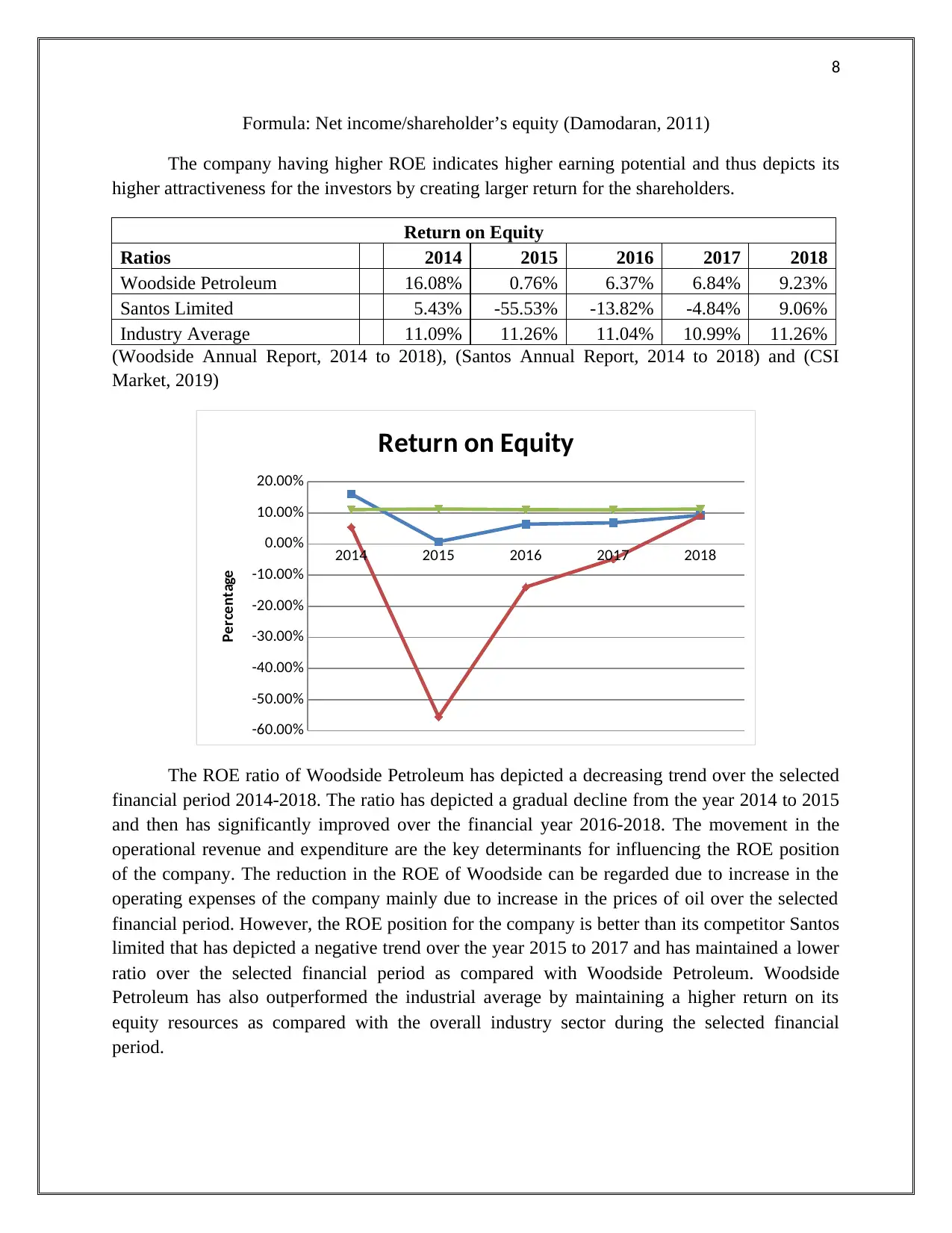
8
Formula: Net income/shareholder’s equity (Damodaran, 2011)
The company having higher ROE indicates higher earning potential and thus depicts its
higher attractiveness for the investors by creating larger return for the shareholders.
Return on Equity
Ratios 2014 2015 2016 2017 2018
Woodside Petroleum 16.08% 0.76% 6.37% 6.84% 9.23%
Santos Limited 5.43% -55.53% -13.82% -4.84% 9.06%
Industry Average 11.09% 11.26% 11.04% 10.99% 11.26%
(Woodside Annual Report, 2014 to 2018), (Santos Annual Report, 2014 to 2018) and (CSI
Market, 2019)
2014 2015 2016 2017 2018
-60.00%
-50.00%
-40.00%
-30.00%
-20.00%
-10.00%
0.00%
10.00%
20.00%
Return on Equity
Percentage
The ROE ratio of Woodside Petroleum has depicted a decreasing trend over the selected
financial period 2014-2018. The ratio has depicted a gradual decline from the year 2014 to 2015
and then has significantly improved over the financial year 2016-2018. The movement in the
operational revenue and expenditure are the key determinants for influencing the ROE position
of the company. The reduction in the ROE of Woodside can be regarded due to increase in the
operating expenses of the company mainly due to increase in the prices of oil over the selected
financial period. However, the ROE position for the company is better than its competitor Santos
limited that has depicted a negative trend over the year 2015 to 2017 and has maintained a lower
ratio over the selected financial period as compared with Woodside Petroleum. Woodside
Petroleum has also outperformed the industrial average by maintaining a higher return on its
equity resources as compared with the overall industry sector during the selected financial
period.
Formula: Net income/shareholder’s equity (Damodaran, 2011)
The company having higher ROE indicates higher earning potential and thus depicts its
higher attractiveness for the investors by creating larger return for the shareholders.
Return on Equity
Ratios 2014 2015 2016 2017 2018
Woodside Petroleum 16.08% 0.76% 6.37% 6.84% 9.23%
Santos Limited 5.43% -55.53% -13.82% -4.84% 9.06%
Industry Average 11.09% 11.26% 11.04% 10.99% 11.26%
(Woodside Annual Report, 2014 to 2018), (Santos Annual Report, 2014 to 2018) and (CSI
Market, 2019)
2014 2015 2016 2017 2018
-60.00%
-50.00%
-40.00%
-30.00%
-20.00%
-10.00%
0.00%
10.00%
20.00%
Return on Equity
Percentage
The ROE ratio of Woodside Petroleum has depicted a decreasing trend over the selected
financial period 2014-2018. The ratio has depicted a gradual decline from the year 2014 to 2015
and then has significantly improved over the financial year 2016-2018. The movement in the
operational revenue and expenditure are the key determinants for influencing the ROE position
of the company. The reduction in the ROE of Woodside can be regarded due to increase in the
operating expenses of the company mainly due to increase in the prices of oil over the selected
financial period. However, the ROE position for the company is better than its competitor Santos
limited that has depicted a negative trend over the year 2015 to 2017 and has maintained a lower
ratio over the selected financial period as compared with Woodside Petroleum. Woodside
Petroleum has also outperformed the industrial average by maintaining a higher return on its
equity resources as compared with the overall industry sector during the selected financial
period.
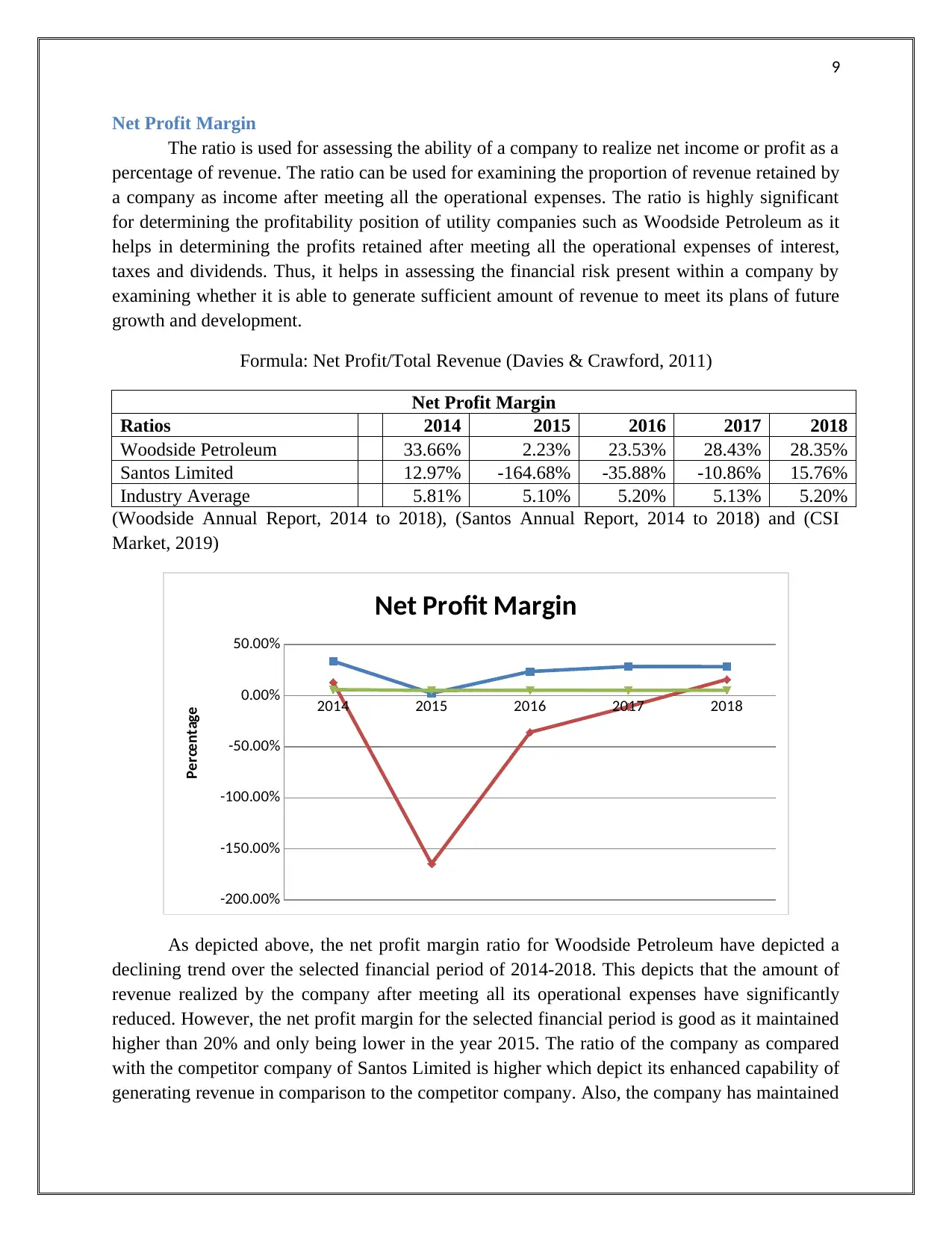
9
Net Profit Margin
The ratio is used for assessing the ability of a company to realize net income or profit as a
percentage of revenue. The ratio can be used for examining the proportion of revenue retained by
a company as income after meeting all the operational expenses. The ratio is highly significant
for determining the profitability position of utility companies such as Woodside Petroleum as it
helps in determining the profits retained after meeting all the operational expenses of interest,
taxes and dividends. Thus, it helps in assessing the financial risk present within a company by
examining whether it is able to generate sufficient amount of revenue to meet its plans of future
growth and development.
Formula: Net Profit/Total Revenue (Davies & Crawford, 2011)
Net Profit Margin
Ratios 2014 2015 2016 2017 2018
Woodside Petroleum 33.66% 2.23% 23.53% 28.43% 28.35%
Santos Limited 12.97% -164.68% -35.88% -10.86% 15.76%
Industry Average 5.81% 5.10% 5.20% 5.13% 5.20%
(Woodside Annual Report, 2014 to 2018), (Santos Annual Report, 2014 to 2018) and (CSI
Market, 2019)
2014 2015 2016 2017 2018
-200.00%
-150.00%
-100.00%
-50.00%
0.00%
50.00%
Net Profit Margin
Percentage
As depicted above, the net profit margin ratio for Woodside Petroleum have depicted a
declining trend over the selected financial period of 2014-2018. This depicts that the amount of
revenue realized by the company after meeting all its operational expenses have significantly
reduced. However, the net profit margin for the selected financial period is good as it maintained
higher than 20% and only being lower in the year 2015. The ratio of the company as compared
with the competitor company of Santos Limited is higher which depict its enhanced capability of
generating revenue in comparison to the competitor company. Also, the company has maintained
Net Profit Margin
The ratio is used for assessing the ability of a company to realize net income or profit as a
percentage of revenue. The ratio can be used for examining the proportion of revenue retained by
a company as income after meeting all the operational expenses. The ratio is highly significant
for determining the profitability position of utility companies such as Woodside Petroleum as it
helps in determining the profits retained after meeting all the operational expenses of interest,
taxes and dividends. Thus, it helps in assessing the financial risk present within a company by
examining whether it is able to generate sufficient amount of revenue to meet its plans of future
growth and development.
Formula: Net Profit/Total Revenue (Davies & Crawford, 2011)
Net Profit Margin
Ratios 2014 2015 2016 2017 2018
Woodside Petroleum 33.66% 2.23% 23.53% 28.43% 28.35%
Santos Limited 12.97% -164.68% -35.88% -10.86% 15.76%
Industry Average 5.81% 5.10% 5.20% 5.13% 5.20%
(Woodside Annual Report, 2014 to 2018), (Santos Annual Report, 2014 to 2018) and (CSI
Market, 2019)
2014 2015 2016 2017 2018
-200.00%
-150.00%
-100.00%
-50.00%
0.00%
50.00%
Net Profit Margin
Percentage
As depicted above, the net profit margin ratio for Woodside Petroleum have depicted a
declining trend over the selected financial period of 2014-2018. This depicts that the amount of
revenue realized by the company after meeting all its operational expenses have significantly
reduced. However, the net profit margin for the selected financial period is good as it maintained
higher than 20% and only being lower in the year 2015. The ratio of the company as compared
with the competitor company of Santos Limited is higher which depict its enhanced capability of
generating revenue in comparison to the competitor company. Also, the company has maintained
⊘ This is a preview!⊘
Do you want full access?
Subscribe today to unlock all pages.

Trusted by 1+ million students worldwide
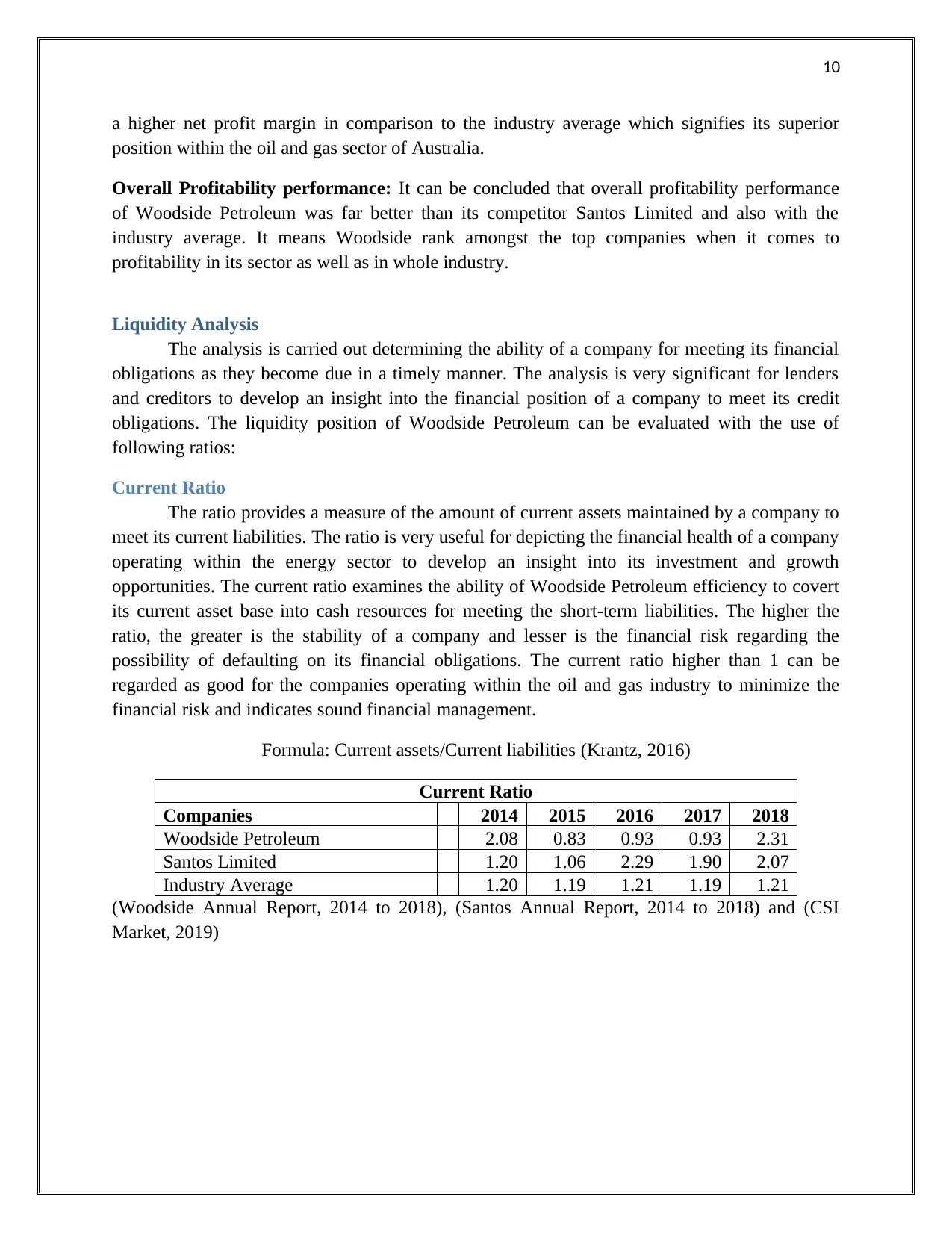
10
a higher net profit margin in comparison to the industry average which signifies its superior
position within the oil and gas sector of Australia.
Overall Profitability performance: It can be concluded that overall profitability performance
of Woodside Petroleum was far better than its competitor Santos Limited and also with the
industry average. It means Woodside rank amongst the top companies when it comes to
profitability in its sector as well as in whole industry.
Liquidity Analysis
The analysis is carried out determining the ability of a company for meeting its financial
obligations as they become due in a timely manner. The analysis is very significant for lenders
and creditors to develop an insight into the financial position of a company to meet its credit
obligations. The liquidity position of Woodside Petroleum can be evaluated with the use of
following ratios:
Current Ratio
The ratio provides a measure of the amount of current assets maintained by a company to
meet its current liabilities. The ratio is very useful for depicting the financial health of a company
operating within the energy sector to develop an insight into its investment and growth
opportunities. The current ratio examines the ability of Woodside Petroleum efficiency to covert
its current asset base into cash resources for meeting the short-term liabilities. The higher the
ratio, the greater is the stability of a company and lesser is the financial risk regarding the
possibility of defaulting on its financial obligations. The current ratio higher than 1 can be
regarded as good for the companies operating within the oil and gas industry to minimize the
financial risk and indicates sound financial management.
Formula: Current assets/Current liabilities (Krantz, 2016)
Current Ratio
Companies 2014 2015 2016 2017 2018
Woodside Petroleum 2.08 0.83 0.93 0.93 2.31
Santos Limited 1.20 1.06 2.29 1.90 2.07
Industry Average 1.20 1.19 1.21 1.19 1.21
(Woodside Annual Report, 2014 to 2018), (Santos Annual Report, 2014 to 2018) and (CSI
Market, 2019)
a higher net profit margin in comparison to the industry average which signifies its superior
position within the oil and gas sector of Australia.
Overall Profitability performance: It can be concluded that overall profitability performance
of Woodside Petroleum was far better than its competitor Santos Limited and also with the
industry average. It means Woodside rank amongst the top companies when it comes to
profitability in its sector as well as in whole industry.
Liquidity Analysis
The analysis is carried out determining the ability of a company for meeting its financial
obligations as they become due in a timely manner. The analysis is very significant for lenders
and creditors to develop an insight into the financial position of a company to meet its credit
obligations. The liquidity position of Woodside Petroleum can be evaluated with the use of
following ratios:
Current Ratio
The ratio provides a measure of the amount of current assets maintained by a company to
meet its current liabilities. The ratio is very useful for depicting the financial health of a company
operating within the energy sector to develop an insight into its investment and growth
opportunities. The current ratio examines the ability of Woodside Petroleum efficiency to covert
its current asset base into cash resources for meeting the short-term liabilities. The higher the
ratio, the greater is the stability of a company and lesser is the financial risk regarding the
possibility of defaulting on its financial obligations. The current ratio higher than 1 can be
regarded as good for the companies operating within the oil and gas industry to minimize the
financial risk and indicates sound financial management.
Formula: Current assets/Current liabilities (Krantz, 2016)
Current Ratio
Companies 2014 2015 2016 2017 2018
Woodside Petroleum 2.08 0.83 0.93 0.93 2.31
Santos Limited 1.20 1.06 2.29 1.90 2.07
Industry Average 1.20 1.19 1.21 1.19 1.21
(Woodside Annual Report, 2014 to 2018), (Santos Annual Report, 2014 to 2018) and (CSI
Market, 2019)
Paraphrase This Document
Need a fresh take? Get an instant paraphrase of this document with our AI Paraphraser
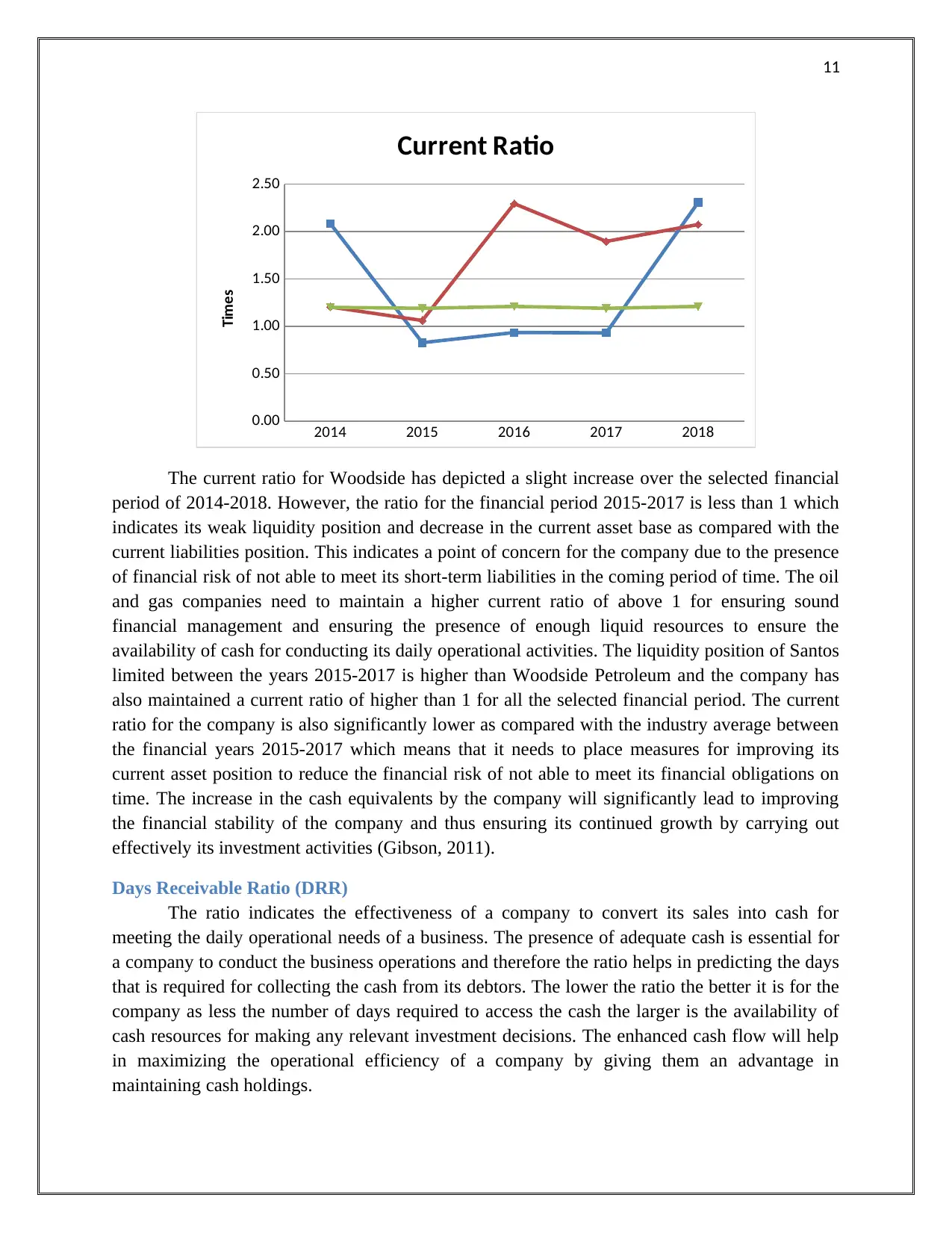
11
2014 2015 2016 2017 2018
0.00
0.50
1.00
1.50
2.00
2.50
Current Ratio
Times
The current ratio for Woodside has depicted a slight increase over the selected financial
period of 2014-2018. However, the ratio for the financial period 2015-2017 is less than 1 which
indicates its weak liquidity position and decrease in the current asset base as compared with the
current liabilities position. This indicates a point of concern for the company due to the presence
of financial risk of not able to meet its short-term liabilities in the coming period of time. The oil
and gas companies need to maintain a higher current ratio of above 1 for ensuring sound
financial management and ensuring the presence of enough liquid resources to ensure the
availability of cash for conducting its daily operational activities. The liquidity position of Santos
limited between the years 2015-2017 is higher than Woodside Petroleum and the company has
also maintained a current ratio of higher than 1 for all the selected financial period. The current
ratio for the company is also significantly lower as compared with the industry average between
the financial years 2015-2017 which means that it needs to place measures for improving its
current asset position to reduce the financial risk of not able to meet its financial obligations on
time. The increase in the cash equivalents by the company will significantly lead to improving
the financial stability of the company and thus ensuring its continued growth by carrying out
effectively its investment activities (Gibson, 2011).
Days Receivable Ratio (DRR)
The ratio indicates the effectiveness of a company to convert its sales into cash for
meeting the daily operational needs of a business. The presence of adequate cash is essential for
a company to conduct the business operations and therefore the ratio helps in predicting the days
that is required for collecting the cash from its debtors. The lower the ratio the better it is for the
company as less the number of days required to access the cash the larger is the availability of
cash resources for making any relevant investment decisions. The enhanced cash flow will help
in maximizing the operational efficiency of a company by giving them an advantage in
maintaining cash holdings.
2014 2015 2016 2017 2018
0.00
0.50
1.00
1.50
2.00
2.50
Current Ratio
Times
The current ratio for Woodside has depicted a slight increase over the selected financial
period of 2014-2018. However, the ratio for the financial period 2015-2017 is less than 1 which
indicates its weak liquidity position and decrease in the current asset base as compared with the
current liabilities position. This indicates a point of concern for the company due to the presence
of financial risk of not able to meet its short-term liabilities in the coming period of time. The oil
and gas companies need to maintain a higher current ratio of above 1 for ensuring sound
financial management and ensuring the presence of enough liquid resources to ensure the
availability of cash for conducting its daily operational activities. The liquidity position of Santos
limited between the years 2015-2017 is higher than Woodside Petroleum and the company has
also maintained a current ratio of higher than 1 for all the selected financial period. The current
ratio for the company is also significantly lower as compared with the industry average between
the financial years 2015-2017 which means that it needs to place measures for improving its
current asset position to reduce the financial risk of not able to meet its financial obligations on
time. The increase in the cash equivalents by the company will significantly lead to improving
the financial stability of the company and thus ensuring its continued growth by carrying out
effectively its investment activities (Gibson, 2011).
Days Receivable Ratio (DRR)
The ratio indicates the effectiveness of a company to convert its sales into cash for
meeting the daily operational needs of a business. The presence of adequate cash is essential for
a company to conduct the business operations and therefore the ratio helps in predicting the days
that is required for collecting the cash from its debtors. The lower the ratio the better it is for the
company as less the number of days required to access the cash the larger is the availability of
cash resources for making any relevant investment decisions. The enhanced cash flow will help
in maximizing the operational efficiency of a company by giving them an advantage in
maintaining cash holdings.
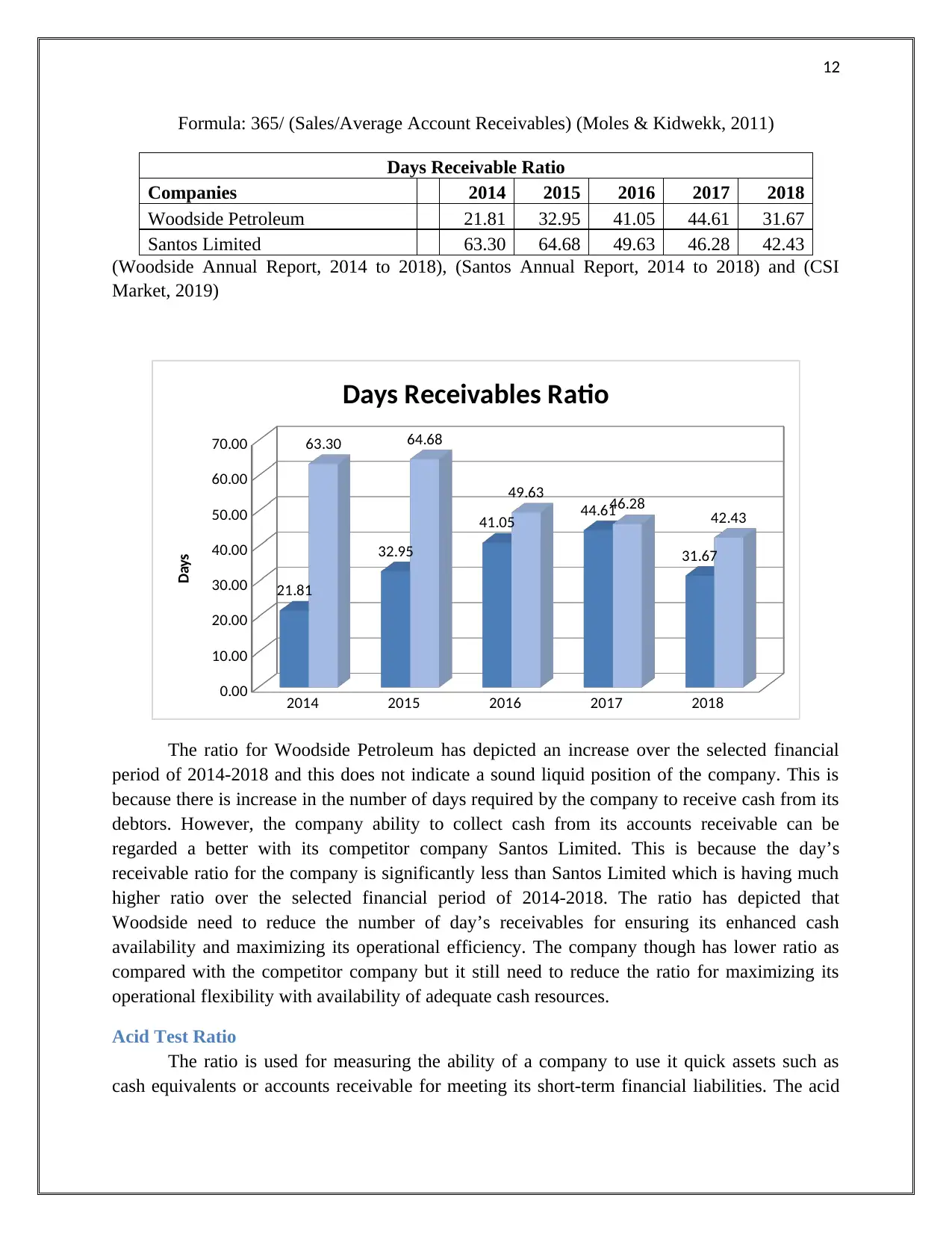
12
Formula: 365/ (Sales/Average Account Receivables) (Moles & Kidwekk, 2011)
Days Receivable Ratio
Companies 2014 2015 2016 2017 2018
Woodside Petroleum 21.81 32.95 41.05 44.61 31.67
Santos Limited 63.30 64.68 49.63 46.28 42.43
(Woodside Annual Report, 2014 to 2018), (Santos Annual Report, 2014 to 2018) and (CSI
Market, 2019)
2014 2015 2016 2017 2018
0.00
10.00
20.00
30.00
40.00
50.00
60.00
70.00
21.81
32.95
41.05 44.61
31.67
63.30 64.68
49.63 46.28 42.43
Days Receivables Ratio
Days
The ratio for Woodside Petroleum has depicted an increase over the selected financial
period of 2014-2018 and this does not indicate a sound liquid position of the company. This is
because there is increase in the number of days required by the company to receive cash from its
debtors. However, the company ability to collect cash from its accounts receivable can be
regarded a better with its competitor company Santos Limited. This is because the day’s
receivable ratio for the company is significantly less than Santos Limited which is having much
higher ratio over the selected financial period of 2014-2018. The ratio has depicted that
Woodside need to reduce the number of day’s receivables for ensuring its enhanced cash
availability and maximizing its operational efficiency. The company though has lower ratio as
compared with the competitor company but it still need to reduce the ratio for maximizing its
operational flexibility with availability of adequate cash resources.
Acid Test Ratio
The ratio is used for measuring the ability of a company to use it quick assets such as
cash equivalents or accounts receivable for meeting its short-term financial liabilities. The acid
Formula: 365/ (Sales/Average Account Receivables) (Moles & Kidwekk, 2011)
Days Receivable Ratio
Companies 2014 2015 2016 2017 2018
Woodside Petroleum 21.81 32.95 41.05 44.61 31.67
Santos Limited 63.30 64.68 49.63 46.28 42.43
(Woodside Annual Report, 2014 to 2018), (Santos Annual Report, 2014 to 2018) and (CSI
Market, 2019)
2014 2015 2016 2017 2018
0.00
10.00
20.00
30.00
40.00
50.00
60.00
70.00
21.81
32.95
41.05 44.61
31.67
63.30 64.68
49.63 46.28 42.43
Days Receivables Ratio
Days
The ratio for Woodside Petroleum has depicted an increase over the selected financial
period of 2014-2018 and this does not indicate a sound liquid position of the company. This is
because there is increase in the number of days required by the company to receive cash from its
debtors. However, the company ability to collect cash from its accounts receivable can be
regarded a better with its competitor company Santos Limited. This is because the day’s
receivable ratio for the company is significantly less than Santos Limited which is having much
higher ratio over the selected financial period of 2014-2018. The ratio has depicted that
Woodside need to reduce the number of day’s receivables for ensuring its enhanced cash
availability and maximizing its operational efficiency. The company though has lower ratio as
compared with the competitor company but it still need to reduce the ratio for maximizing its
operational flexibility with availability of adequate cash resources.
Acid Test Ratio
The ratio is used for measuring the ability of a company to use it quick assets such as
cash equivalents or accounts receivable for meeting its short-term financial liabilities. The acid
⊘ This is a preview!⊘
Do you want full access?
Subscribe today to unlock all pages.

Trusted by 1+ million students worldwide
1 out of 23
Related Documents
Your All-in-One AI-Powered Toolkit for Academic Success.
+13062052269
info@desklib.com
Available 24*7 on WhatsApp / Email
![[object Object]](/_next/static/media/star-bottom.7253800d.svg)
Unlock your academic potential
Copyright © 2020–2025 A2Z Services. All Rights Reserved. Developed and managed by ZUCOL.





